E. Roberts
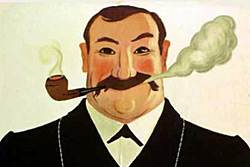 Pipe filters tend to get a bum rap, at least more so here in the States than abroad, particularly Europe. Countless times, I’ve seen threads on the forums in which a beginner asks about the filter that came with a brand new or estate pipe, only to be told that they are categorically without merit, and should be tossed in the nearest wastebasket. But how can this be? If they were so useless, why would major producers—companies like Missouri Meerschaum, Dunhill, Savinelli, Brigham, to name a few—continue to make pipes chambered for a variety of filters? Sure, we Americans are the rough and tumble sort, quick to eschew gimmicks and gadgetry in favor of pure performance, but surely there must be some segment of the populace that demands these devices, or the simple fact is that the market would no longer bear their production.
Pipe filters tend to get a bum rap, at least more so here in the States than abroad, particularly Europe. Countless times, I’ve seen threads on the forums in which a beginner asks about the filter that came with a brand new or estate pipe, only to be told that they are categorically without merit, and should be tossed in the nearest wastebasket. But how can this be? If they were so useless, why would major producers—companies like Missouri Meerschaum, Dunhill, Savinelli, Brigham, to name a few—continue to make pipes chambered for a variety of filters? Sure, we Americans are the rough and tumble sort, quick to eschew gimmicks and gadgetry in favor of pure performance, but surely there must be some segment of the populace that demands these devices, or the simple fact is that the market would no longer bear their production.
You might be surprised to see the sales figures of filter-capable pipes, both here and abroad. While folks like us that partake in the online community and attend pipe shows (let’s call ourselves "advanced" users) may see ourselves as indicative of the overall industry, that’s not quite the whole picture. In truth, we’re but a tiny percentage of a miniscule industry when scaled against tobacco in general, though our ranks are growing daily. The fact is, the vast majority of pipe smokers do not participate in online discussion groups, pipe shows or even pipe clubs; they’re mostly lone wolves who are content in their solitary enjoyments. And while some higher-end marques and carvers chamber their pipes for filters, the majority of filter pipes are in the more modest echelons of price. Ask any retailer or etailer, and the story is the same: bargain pipes outsell high grade and artisan pipes by a spectacular margin. While the greats are great for very good reason, I’m sure that Rad Davis, Paolo Becker or Tonni Nielsen would kill for the sales figures of Dr. Grabow.
So what are the benefits of filter pipes, and what are the drawbacks? Pipe filters are generally built around the concept of cooling the smoke and removing moisture as well as tar and other by-products of combustion. Moisture and combustion by-products are inescapable in pipe smoking, obviously, so why try to remove them? Moisture in part is what delivers the flavor of burning tobacco, so why would one wish to remove it from the smoke? One reason is that excessive moisture can actually detract from the smoking experience in a number of ways: by causing gurgle, or a buildup of condensed moisture that blocks the draft hole; by "spitting", which occurs when the built up moisture enters the smoker’s mouth from the bit; and by exacerbating the effects of tongue burn from the hot steam. A number of engineering means have been employed to mitigate excessive moisture in the smoke stream, notably the design of gourd calabash pipes, Peterson system pipes, and newer incarnations such as the reverse calabash varieties, as innovated by the likes of Rolando Negoita. To some degree, all of these systems will remove an amount of combustion by-products as well, suspended in the collected moisture.
This article will focus on several mechanical means to attenuate moisture and by-products: pass-through filters, which include paper, carbon and silica crystal cartridges; fibrous filters including wood and cotton; and "stingers", or mechanical condensation baffles. I hope it will help dispel some myths about the reputation filters have here, and perhaps help both beginners and advanced users better understand and appreciate their use and benefits. While this list is by no means exhaustive, it hopes to cover the prevalent types of filters available. Most opponents of filter use cite the increased resistance in the draw and the cleaning maintenance as the main shortcomings, which will be addressed on an individual basis.
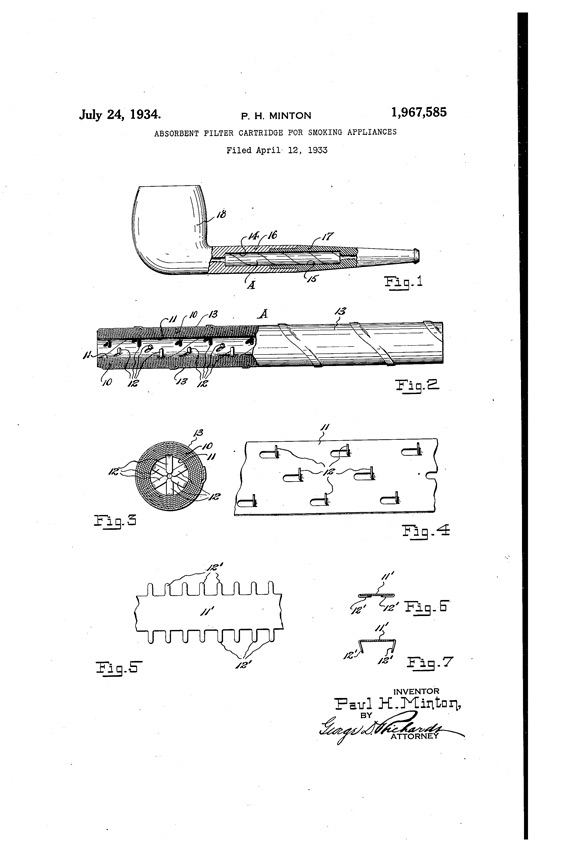
The landmark Medico patent.
The most commonly encountered paper filters here in the States are either Medico branded, or variations on their 1933 patent. The engineering is simple and effective for this pass-through style of filter: a paper tube (either 6mm or 9mm) with a number of perforated baffles on its interior, covered in a thin cellophane wrapper. As mentioned, many styles of Missouri Meerschaum Corncob pipes come standard with a Medico brand filter, as do Medico brand pipes, naturally. Able to be used over the course of several smokes before being disposed of, they’re also quite economical, currently running around $0.80 per box of ten.
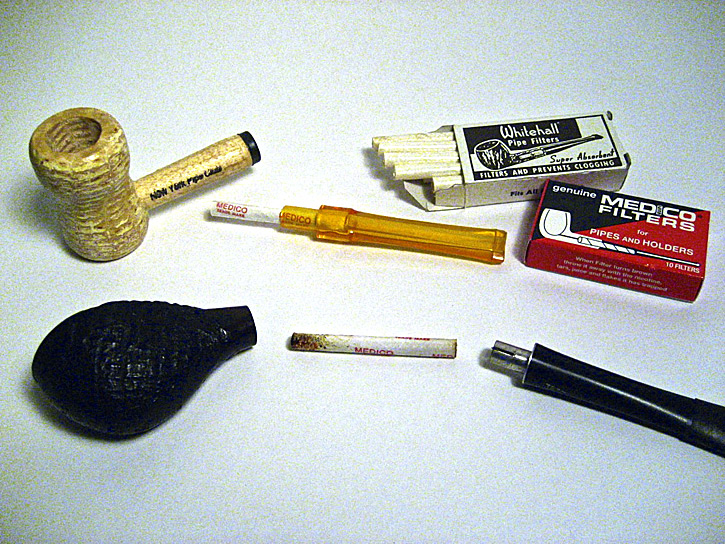
Medico filters in the wild.
While there is obviously added turbulence and resistance to the airstream, the effect on the draw is actually minimal, and easily mitigated with minor adjustments to one’s technique and tobacco choice. I personally have a great fondness for a certain style of Medico pipe, and always enjoy them with their filter in place, finding that the draw without them is actually unbalanced. While the trope that "your mileage may vary" certainly applies, I find them best suited to particularly moist aromatic blends or flakes, for example Sutliff’s Molto Dolce or Esoterica’s Penzance, serving to allow a great smoke while regulating the moisture content effectively. They’re also aces with tobacco that’s a bit crumbly and prone to flying into your mouth. Once you’ve adjusted to them, they’re well worth the effort. Again, I feel the slight airflow restriction to be wildly overblown in many discussions of the subject, and as a professional tobacco taster I can attest that there is no adverse effect on flavor when employed properly—e.g., not re-using filters, not using them past the point that they’re drenched with moisture and black with tar, etcetera. In other words, common sense should prevail in their use. There are also versions with activated carbon-infused paper in the baffles, which have similar overall characteristics. They require no special care, and actually make the pipe shank easier to clean.
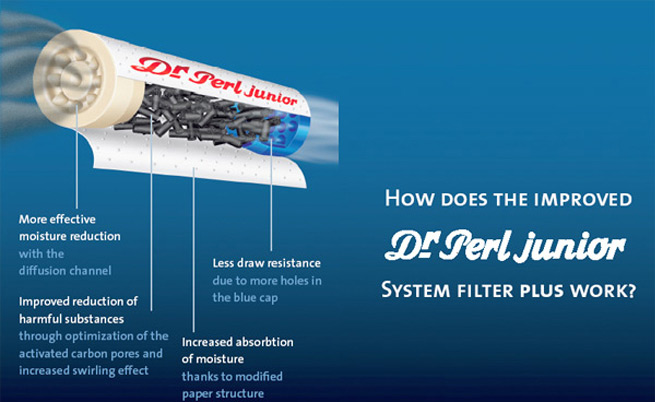
The mechanics of cartridge filters.
The European market favors the 9mm cartridge filter. Similar in concept to the all-paper Medico style, this type of filter employs either activated charcoal, meerschaum granules, or silica crystals wrapped in a paper cartridge and capped with plastic or ceramic ends. Working on the same principle of capillary action as the Medico style, they leech moisture from the smoke stream by adsorption, with the added benefit of chemically bonding to carbon-based impurities. While the overall health benefits are debatable, they are wildly popular on the Continent, particularly in Germany. The draw restriction tends to be more substantial with these types, owing to the limitation of the holes in the end caps, but again, proper technique and practice are really all that is required to obviate this hindrance. Vauen and Denicotea are the major producers of this style, and most top European factory pipe brands offer pipes chambered for them—including Dunhill, Peterson, and Savinelli, among others.
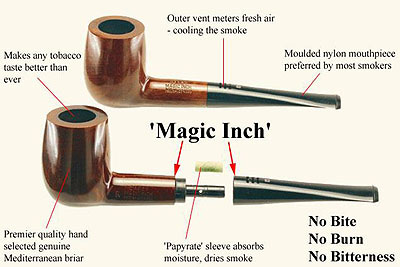
The mechanics of the "Magic Inch" system
The Carey Magic Inch is an interesting and singular take on absorptive filtration. At the tenon of a Magic Inch pipe there are perforations, as well as on the mortise of the stem side of the connection. Over these holes is placed the "papyrate" filter, a paper-like sleeve. During a smoke, the turbulence and temperature differential of the perforated airway condenses moisture, while the permeable sleeve allows cooler air in while evaporating collected moisture. There is no draw resistance; in fact, the draw without the sleeve is nearly impossible, while with the sleeve in place it is quite satisfactory. While the overall rate of moisture removal is small, it does function as advertised. I scoured a popular online auction site for a suitable pipe for this article, and although the weight of the pipe is a bit heavy for my preference to clench, the smoke in it was quite good, and noticeably decreased in moisture, albeit not a game changer. One peculiar flaw in this design is the propensity for the moisture to seep out of the perforated stem once the sleeve is saturated—the rate of absorption outpaces the rate of evaporation quite a bit under normal conditions. This is a non-restrictive system, allowing you to insert a pipe cleaner all the way through the stem to absorb excess moisture. EA Carey is the sole producer of this style of pipe and its filters. They do require frequent changing and a bit of cleaning around the "Magic Inch".
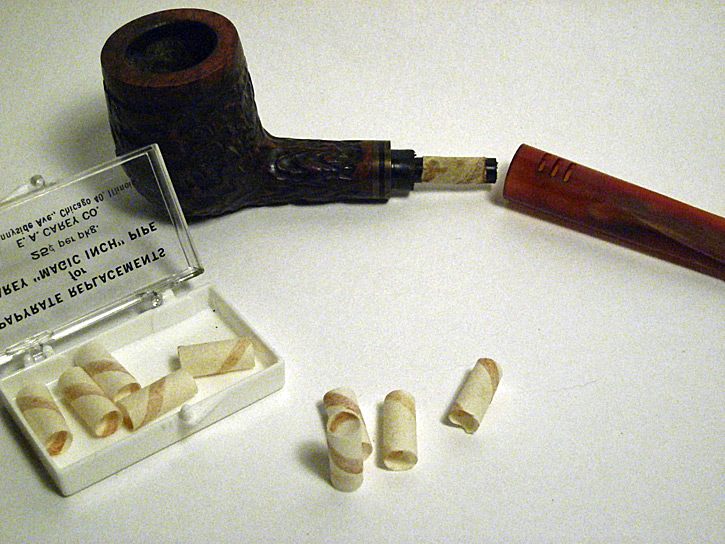
The Carey "Magic Inch" pipe in action.
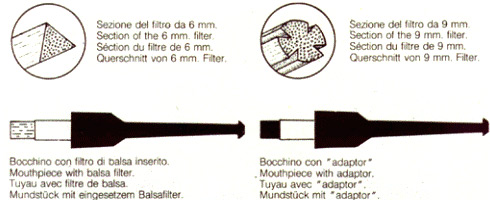
Read more about Savinelli in the PipeSMOKE Magazine Archives, only at PipesMagazine.com!
Balsa wood has long been known as a wonderful natural material for moisture absorption. An extremely lightweight and low-density wood, "balsa" in fact comes from the Spanish word for "raft". Savinelli is the brand that is most associated with this style of in-line filter, offering both 6mm and 9mm sizes, and in both a triangular cross-section as well as a cloverleaf cross-section, although there are many other manufacturers of similar styles. The filter works by collecting moisture that condenses as it passes over the wood; balsa can surprisingly hold on the order of eighteen thousand times its weight in water. They also claim to absorb 77% of the nicotine and 91% of the tar from the smoke stream, as tested by independent laboratories. I personally love my Savinelli for aromatics that need just a little tempering, although it works equally well on any style of tobacco you choose. Another advantage of this style is that there is no appreciable restriction of draw, although like paper or cartridge filters you won’t be able to thread a pipe cleaner through the stem while smoking—though the use of the filter should obviate the need for such. In addition to balsa, there are similarly shaped versions available in natural cotton, displaying similar dehumidification properties.
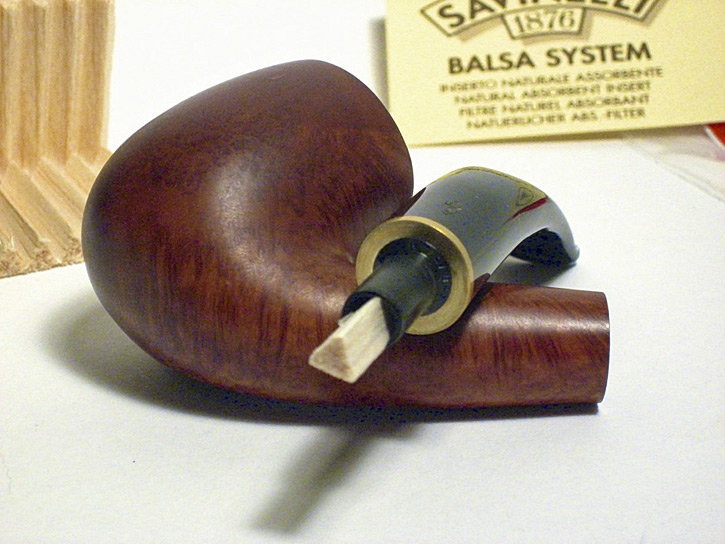
One of my favorite pipes, particularly for taste testing aromatics.
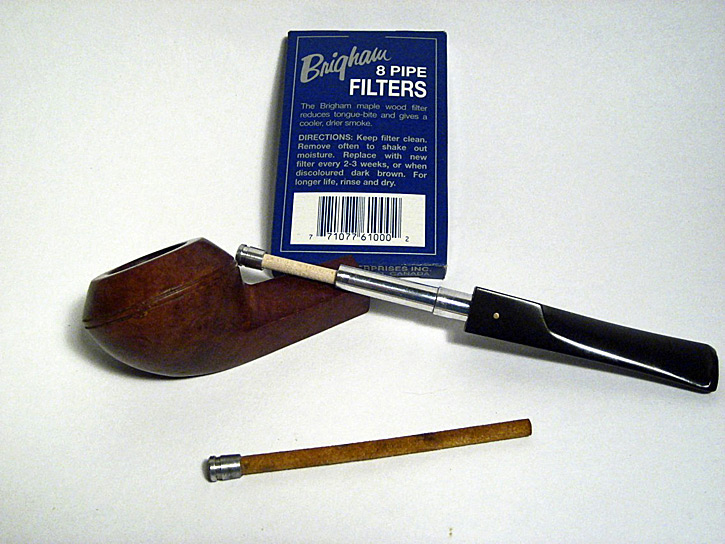
A classic patent-era Brigham bulldog.
Brigham pipes have a unique take on the wood filtration system, employing a hollowed-out rock maple tube that is inserted in the stem. Similar to Dunhill’s innertube (patented!), it lines the stem and shank of the pipe. Like the balsa system, the wood is remarkably absorbent; here, though, there is no obstruction to the airflow from in-line turbulence. While the filter does reduce the draft hole, from approximately 5.75mm to 3mm, it does not impede the draw to uncomfortable levels, and will pass a pipe cleaner unimpeded. I find the system fantastic, one of the best and least intrusive to the smoking experience, and remarkably effective at attenuating moisture. I also find them a handy choice for situations like pipe shows, when I may want to sample several blends but not carry a dozen pipes—simply swapping out a used filter for a new one once the pipe has cooled allows for a fairly unfettered taste of different blends. Brigham is the only producer of their filter system pipes.
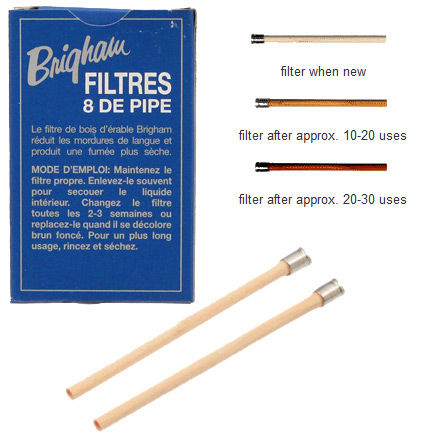
Brigham’s system explained.
Another point to note with wood filters is that they are technically reusable. Once laden, the filters can be boiled in water to remove the oils collected, then dried and redeployed. I’ve tried this with both the balsa and maple Brigham styles, and find that it’s a lot of work just to save a few pennies, and doesn’t satisfactorily remove the odor of its first use. At their modest price points of a couple dollars for 10 or 20 filters that will last through a dozen bowls or more, I prefer to use them once and dispose of them, considering it a minor investment for a small portion of my collection.
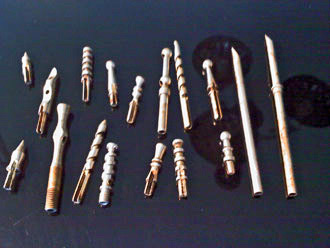
A collection of stingers, courtesy of SmokingPipes.com
Few words in the lexicon of pipedom inspire as much fear and loathing as the dreaded "stinger". Few topics engender such divisive opinions, with one camp advocating circumcision as the only sane choice, while the other meekly defends keeping them in the name of original integrity. If we can step back calmly from that brink to examine the concept, we can also hopefully diffuse some of the misconceptions and bad reputation stingers have.
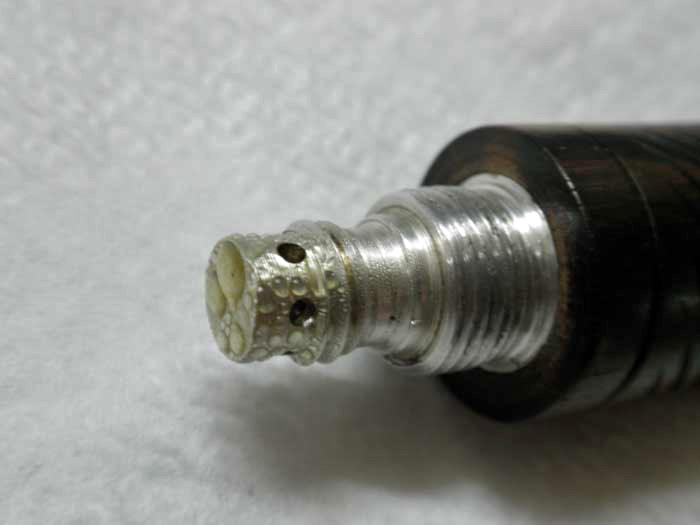
Aspida, conceived by Kostas Gourvelos.
Stingers, though varying widely in design from pipe to pipe, all work on the same principle. By introducing turbulence to the smoke stream with a material that remains at a lower temperature than the smoke, moisture is removed through condensation and, ideally, directed away from the air passage. Hundreds of variations on this design have been employed throughout the years, perhaps most notably by the Kaywoodie brand. Also, see this month’s article interviewing pipe carver Kostas Gourvelos, who has invented an interesting device that combines a stinger with a filter chamber—I haven’t tried it yet, but I’m definitely going to invest in one soon. The big drawback with stingers is generally that they work against themselves—they condense moisture out of the smoke really well, but that in turn tends to clog the reduced air passages in the device itself. There are work-arounds to this, such as unscrewing the tenon to wipe the stinger clean—you’re definitely not going to be able to thread a pipe cleaner through most styles. They also need more meticulous cleaning than other pipes to keep them looking good.
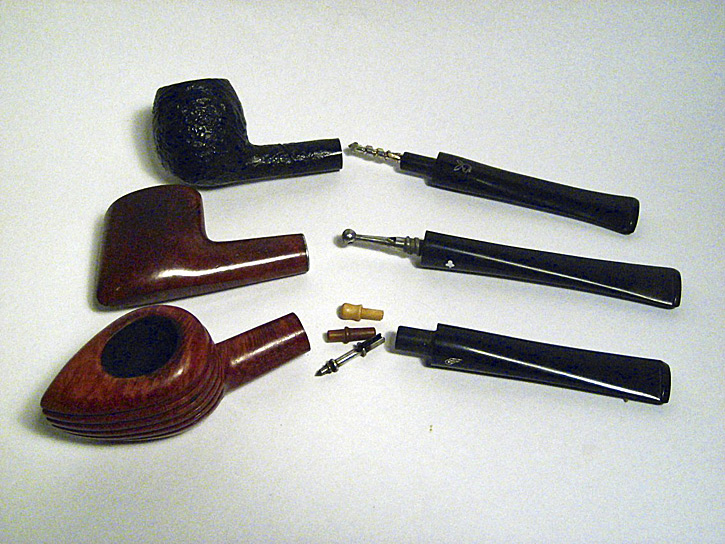
Kaywoodie SuperGrain, Genod Playboy, and CB Weber pipes, all with stingers intact; the Weber actually provides three interchangeable options.
While I do smoke several pipes with their stingers intact, I must always give myself a pre-smoke coaching: "I will smoke as slowly as humanly possible; no, even slower than that, and I WILL NOT gurgle." Much of the time this little serenity prayer works…but not always. Stingers are also good at preventing debris from flying up into your mouth, but are conversely easily clogged by said debris. They’re definitely an acquired skill, but once you have mastered their technique you will be the envy of everyone in your local pipe club. As a side note, pipes with stingers often carry reduced prices on the estate market.
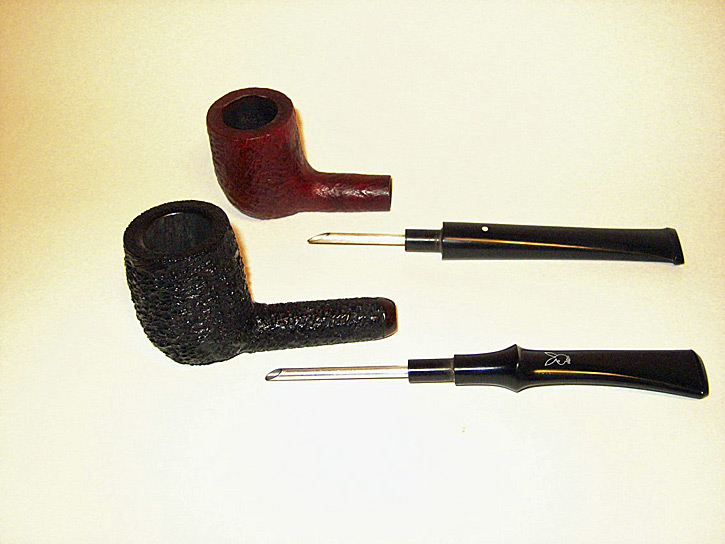
Dunhill and Genod inner tubes.
The Dunhill innertube (patented!) is technically not really a filter, but it does act as a condensing chamber. I personally find them too brill (that’s King’s English for quite adequate, thank you) for keeping the shank and stem clean, as they prevent the oils and tars from soaking in there. They also do not inhibit the draw, and allow a cleaner all the way through to the heel.
Another type of filter that warrants its own category is the meerschaum or chalk clay button, which is placed at the bottom of the chamber, below the tobacco and in front of the draft hole. The upside of this type of device is that it can be used in any pipe, is easily re-used, and utterly unnoticeable in the smoking mechanic. "Philtpad" is a classic brand that still produces them, and vintage examples can be found without too much trouble at antique shops and auction sites. Clay buttons can be boiled or re-fired clean; meer, not so much. Meerschaum granules are also available, from the German brand White Elephant. I use mine religiously in a particular few pipes, deep-chambered bents with narrow drafts. I rarely smoked these pipes because of their proclivity to percolate like a coffee pot, until I discovered the buttons in an estate lot I’d purchased. Now they’re my go-to pipes for moist, rich flakes, like the testing batch of a certain forthcoming Mac Baren release which I’ll be reviewing here next month…

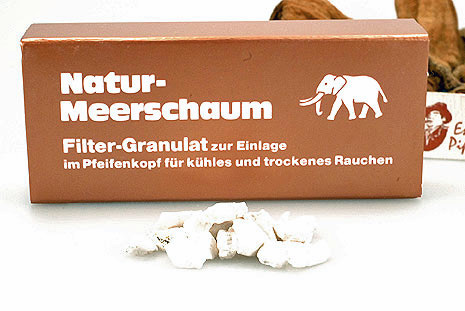
One of the least intrusive types of filtration.
We filter the oil in our cars, the water from our taps, and the air in our living rooms; why then so much disdain for pipe filters? It would be a disservice to your own education as a pipe smoker not to at least try some of the various types of filters available, in order to weigh the pros and cons for yourself. If you find that you don’t like them at all—not in a box, not with a fox, not in a house, not with a mouse—they’re generally easy enough to dispense with, as there are adapters that will retrofit a filter-chambered pipe down to a "normal" draft hole size (which size that may be is another topic of heated debate in the pipe world). The next time you pick up an MM cob, keep the filter and remember to adjust your cadence; smoke slowly but continually, and draw lightly—you may just be rewarded. I for one enjoy them in their various flavors, as noted in all the images of well-used pipes from my own collection, and I’m interested to read your take on them in the comments section below.




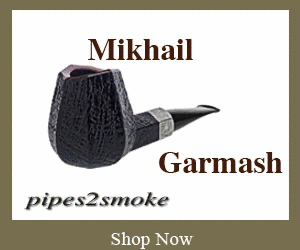







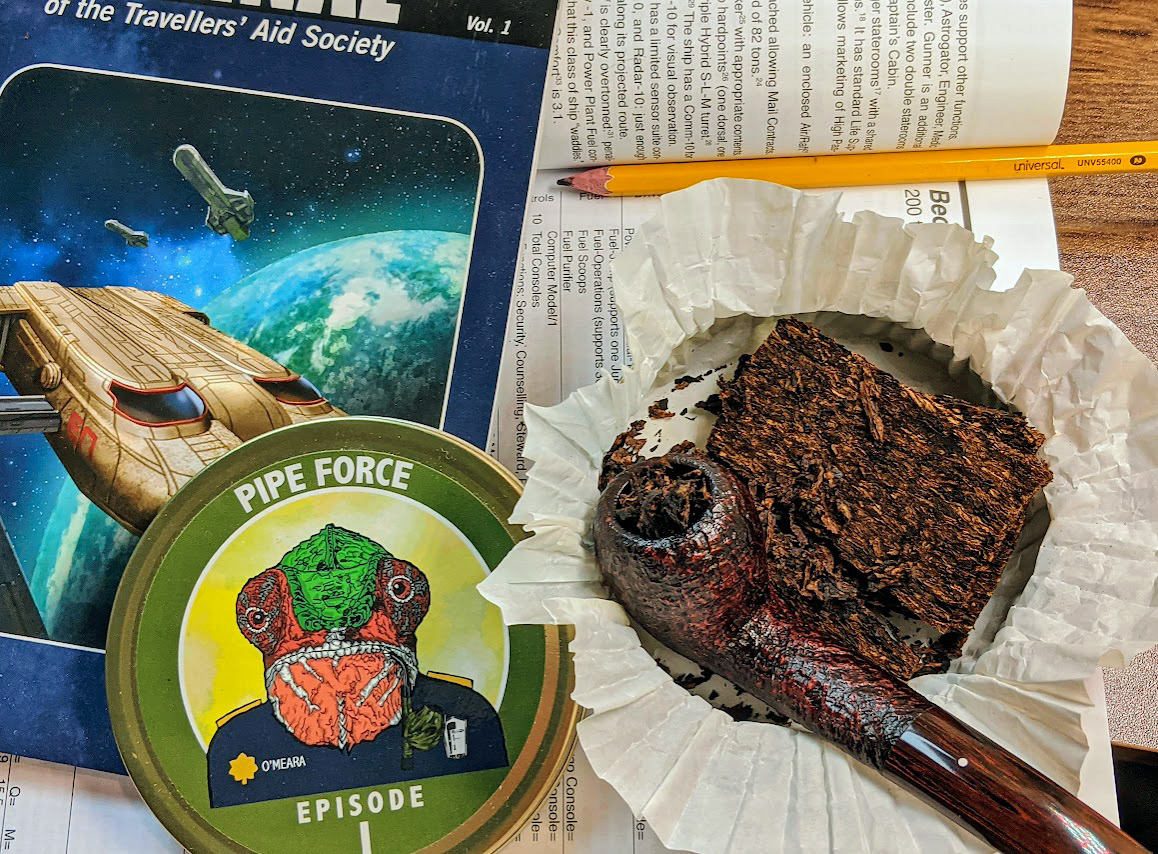





Funny enough I find the best filter ever for a 9mm is a bent up pipe cleaner, I’ve never had a drier smoke with no impact on the taste or draw.
Wonderful article! That’s a very in depth look at the world of filters. Learned a lot. Thanks.
Excellent article! I don’t use filters but loved the knowledge-fest.
The simplest ideas can make the most sense and I will try this.
Good article but I rarely use filters.
Too much trouble for me.
Thanks Romeowood for a very informative, and interesting article. Filters are certainly one area I have been quite ignorant of, and am glad to have a resource to refer to.
Great article! This will be an invaluable resource for new pipers, and the seasoned vet.
Very interesting article! I’ve never used filters in the past, but have recently purchased a Savinelli that takes the 6mm balsa filter. I use them all the time now with the pipe, as I find they work really well, and have no negative impact on my smoking. I also have a Chacom 2011 POY that takes a 9mm filter. I tried the charcoal filters and did not like them at all. After buying some Savinelli 9mm balsa filters for it, I find it to be one of my favorite pipes, as it works even better than the 6mm filters.
Still not a fan of stingers, and I’ve yet to try a Brigham, but plan on doing so soon.
Thanks for the education!
Awesome article! Learned a lot!
Several of my pipes are filtered and I find them useful for toning down strong blends when
I would prefer a milder smoke with that flavor. This is a good rundown and helps dispel the
categorical rejection of the use of filters.
Great article. I had no idea about the great variety of filter systems.
I almost exclusively smoke filtered pipes, usually with charcoal 9mm (Stanwell or Blitz/Peter Heinrichs), and I don’t want to miss it. One thing I’d like to add is that filtering (= how much taste is the filter removing from the smoke)and drag resistance of 9mm filters relies heavily on the brand and the type (paper, meerschaum or charcoal).
Regards
Sebastian
I have settled on a simple guiding principle for my little pipe collection: Smoke them each the way each was designed to be smoked.
I don’t think I would have bothered before. But it evolved into part of my pipe-smoking pleasure now, to have different techniques and be competent in each of them.
Yes, I can’t get through a bowl of aromatic in my Kaywoodie without tending to the stinger. But all I do is unscrew the stem, flick the stinger end once, give a quick blow through it, and screw the stem back in. It is immediately back to dry smoking again and a pleasant cool taste.
My innertubes — neither here nor there. I don’t notice them doing much different than my unfiltered pipes, both of which I keep a fuzzy pipe cleaner nearby.
To each his own, but I really appreciate this article, since the author’s expertise shores my own preference up enough that I can come out of the closet.
Thanks!
This is the first article I’ve read dedicated to filters and find that I was quit ignorant… Thanks for the good read!
Thanks for this article. I particularly appreciate the perspective on the Lone Wolves. I use the Savinelli 6mm balsas in both my Savs and my MM cobs. They seem to work great!
Never thought I’d read an article in one of the major (tobacco world) publications extolling the benefits of pipe filters !! Thank you!
A very informative in which a lot of knowledge was gained. I belong to the Neanderthal school so you won’t be seeing any filters in my pipes any time soon.
Once I discovered the taste benefits on certain tobaccos, I keep a few 9mm filter pipes in rotation. I don’t enjoy every tobacco in one, but the ones I do use them for are fantastic.
I love my old Kaywoodies and consider hacking the stingers off brutalizing a gem. While most of my pipes are non-filtered I appreciate those I do have and use them on certain blends just because those blends smoke better in them for me.
My Brebbia and Dr Plumb have more challenging style stingers but favored blends for each as well.
This is a great article, nearly in mythbuster status. Thanks
I use a bent piece of a pipe cleaner in my cobs and have found they make for a better smoke. Also, after the first few times I used them and removed them from the pipe after smoking they were brown and wet. This showed me they were removing something from the smoke with no noticeable adverse effects. Might not be for every one or every pipe/tobacco but they seem to work for me.
I was opposed to filters for a while, then I decided to try an MM corn cob pipe. To my surprise not only did I find the filter to be very helpful, I find I prefer my corn cobs pipes over my other non filtered pipes.
It’s beyond me why people tell new pipe smokers to throw away the filter. I’ve been smoking for over twenty years and have only recently (in the last 5 years or so) discovered the wonderful world of the 9mm filter pipe! That’s the only way I roll anymore! Imo, it provides the coolest, most flavorful smoke out there! Besides that it’s better for you!
I have quite a few 9mm pipes, and I smoke them with and without the filter. I find the filters great for driving as I don’t have to use a pipe cleaner. Also, when I try a blend that may be too much of a nic hit, the filter pipes cut down on the nic, and I am able to enjoy a blend that would otherwise have my head spinning.
Thanks for the article. I started pipe smoking in 2009 but only stuck with it for a few months before giving up and going to cigar(which I still love) however in the last 3 months I’ve given my pipes a try again and I find that I’m doing much better. A lot of that improvement is due to me reading a lot of good comments on this site! I mostly smoke cobs at the moment so I’m going to try them with a filter and see what I think!
I have smoked and made filtered pipes since the 60s and I like having all the choices a filter pipe offers. Add tenon adaptor, standard pipe, or paper, charcoal, stick, meerschaum. I like charcoal. It does what I want. More high end pipes are adding 9mms as an option. It solves a lot of old problems. Your article is good, as it assists smokers to not miss a great experience, sweet dry smoke with fewer problems.Thanks.